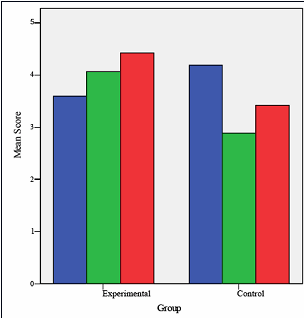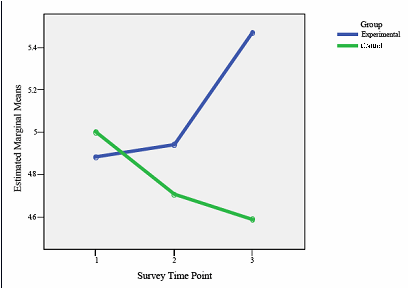| January 2009 Index | Home Page |
Editor’s Note: An overwhelming majority of students have equipment to download and play digital audio files. The researchers achieved favorable results from audio podcasts to supplement traditional instruction for distance learning students. They founds podcasts have the capacity to enhance course perceptions and some aspects of student motivation and performance.
Podcasting: A Method of Enhancing Course Perceptions and Performance in Music Appreciation
Jennifer A. Bugos, Jocelyn Nelson, Michael B. Dixon
USA
Abstract
The overall goal of this research is to examine the effects of auditory learning in podcasting on cognitive engagement. We tested the hypothesis that the addition of weekly audio podcast episodes will enhance academic performance, musical preference, and intrinsic motivation in distance education music appreciation courses. Standard distance learning course materials are predominantly visual. Podcasts reinforce sensory learning and accommodate learning styles. In each of two experiments, we compared two college level on-line music appreciation classes. In experiment 1, students in both classes utilized traditional hard copy texts and received standard visual teacher-made course materials and one class received additional weekly podcast episodes. In experiment 2, both classes utilized online course texts and materials and one class received additional weekly audio podcast episodes. In both experiments, additional episodes contributed to learner perceptions and intrinsic motivation levels.
Keywords: Distance education, distance learning, music, music appreciation, podcast, auditory learning, motivation, performance
Introduction
Distance education refers to “a system of methods, specific tools and forms by means of which the content of the education is transmitted and the goal directed implementation of the aggregate set of pedagogical procedures” (Andreev, 1999, pg. 139). Although pedagogical procedures may vary according to course content, the delivery system can influence overall learning. Course delivery refers to specific methods of accomplishing an integral pedagogical process that have the capacity to facilitate interaction between student and instructor. The purpose of this research is to examine the effects of podcasting on course performance, course perceptions, and intrinsic motivation as an integral part of a course delivery system in an on-line music appreciation course.
Technological advances such as the iPod are shaping the way young adults access auditory information. Audio podcast episodes refer to digital audio files that are downloaded, not as individual MP3s, but as part of a method of delivery for audio files. Audio files are then accessed and available for listening at the user’s convenience. Recent data show that one in four Americans currently owns an iPod or another brand of portable digital music player (Ferguson, et al., 2007). Eighty percent of college students in the United States own at least one device capable of downloading and playing digital audio files. As technology offers increased possibilities for course delivery, educators must evaluate distance education technologies to determine which technologies adequately address the needs of the learner. Evaluation of new technologies on learner-content interactions, learner-instructor interactions, and learner-learner interactions will provide educators with much needed information as to the most effective methods for content delivery. Perceptions of course content and course technology will serve to impact learner-content interactions. Intrinsic motivation levels measure learner-learner outcomes. Perceptions of the instructor will be measured to examine learner-instructor outcomes. Academic success will also provide a measure of the usefulness of the podcasts for music appreciation students.
Most college level distance education courses contain a diverse group of students, traditional and non-traditional. Music appreciation is no exception. One key challenge is to create and maintain course content that accommodates the needs of a diverse group of learners. According to Chickering and Gamson (1991), respecting diverse talents and ways of learning is included as one of the seven principles recommended for good practice in higher education. One way of accommodating learning styles is to present information in multiple formats. This practice is consistent with previous educational research examining learning styles. According to Fleming and Mills, there are four main styles of learning that include visual, auditory, reading/writing, and kinesthetic (1992). Many distance education programs focus primarily upon the visual learning style. This is a key limitation as learning is an active process in which students rely on sensory input to construct meaning. We hypothesize that podcasts will promote cognitive engagement which contributes to enhancement of academic performance, learner perceptions, and intrinsic motivation by accommodating learning styles and providing a sense of interaction with the instructor.
Audio podcast episodes refer to audio files housed on a server and easily accessed at the user’s request. The user has the opportunity to subscribe to specific podcasts or automatically download new podcast episodes. Podcasting has the capacity to accommodate the auditory learner, students with special needs, or those for whom English is a second-language. Sound files can be compressed into MP3 files and uploaded to a server for maximum compatibility. Files are easy to create and inexpensive to distribute. In addition, podcasts containing audio recordings provide the instructor with a record for personal assessment and reflection and can be stored for future use. Students can choose when and where to access podcasts. Technology that offers such convenience combined with a degree of familiarity has the capacity to positivity impact learner investment and thus, has the capacity to influence cognitive engagement.
The purpose of this research is to examine the effects of podcasting as a delivery system on cognitive engagement in an on-line music appreciation course. Distance education courses often require students to be cognitively engaged or invested in their own learning (Fredericks et al., 2004). Cognitive engagement is characterized by self-regulation, investment, and motivation (Corno & Mandinah, 1983). Prior research suggests that cognitive engagement is a construct that is examined by student performance and intrinsic motivation levels (Richardson & Newby, 2006). Intrinsic motivation refers to the engagement of an activity for the pure satisfaction of the activity itself. Intrinsic motivation levels are typically higher in students who attribute educational outcomes to internal factors for which they have control, pursue a topic with a level of interest, and believe in the potential to reach a particular goal. Prior research suggests that intrinsic motivation levels and course attitudes in distance education have a direct effect upon overall course performance (Richardson, 2007). This view, often referred to as self-regulated learning, accounts for differences in higher education course performance through differential study strategies and controlled processes. A general theoretical model proposed by Richardson implicates student motives and attitudes as having the most dramatic impact upon study behaviors (2007). This research focuses upon the evaluation of podcasting on course attitudes and motivation levels. We hypothesize that the experimental group who has access to course podcast episodes will indicate a more positive view of the course, demonstrate higher course performance, and indicate higher levels of intrinsic motivation compared to the control group that does not have access to course podcast episodes.
Methods
Experiment 1:
A quasi-experimental design was used to examine the effects of auditory learning in podcasting on academic achievement, learner perceptions, and musical preferences of college students in a music appreciation distance education course. Two sections of distance education music appreciation courses taught by the same instructor were recruited for research participation. All participants consented to participate in accordance with the procedures established by the East Carolina Institutional Review Board.
One music appreciation class was assigned to the experimental group, receiving weekly audio podcast episodes in addition to standard music appreciation lecture presentations, and the other class was assigned to the control group that did not receive the podcast episodes. Both groups received standard music appreciation course content presented in Blackboard 6.0, a course management system. Prior to the presentation of course content, participants completed a short preliminary questionnaire to collect data regarding musical preference and demographic information. To examine course perceptions and motivations, a modified Intrinsic Motivation Inventory (IMI; McCauley, Duncan, & Tammen, 1989) was administered electronically in Blackboard using password protected access at three time points throughout the course: prior to course participation, mid-way through the course, and upon course completion. The modified IMI consisted of 90 questions administered at each time point to assess motivation, preferences, and attitudes regarding course content and delivery. The IMI consists of statements, such as “I am satisfied with my performance on this task,” and corresponding response choices on a Likert scale 1-7 with three strong categories (not at all true, somewhat true, and very true). The IMI items serve as part of a multidimensional measurement tool that can be modified without effecting reliability or validity (Ryan, Koestner, & Deci, 1991). The IMI is a multidimensional inventory commonly used to measure motivation and self-regulation. Research on the validity of the measure shows strong content validity (McAuley, Duncan, & Tammen, 1989).
Course Description and Course Content
The music appreciation course provides an introduction to basic materials of music for the understanding and enjoyment of music. The course focused predominantly on Western art music from the Medieval Era to the present, and utilized The Enjoyment of Music, 9th brief edition (Machlis & Forney, 2003). This edition presents Western art music chronologically, with brief supplementary material on vernacular and world music traditions. Students were expected to use an interactive CD-ROM and four enhanced multimedia CDs that accompany the text. Each week’s assignments consisted of course readings, short-answer assignments, discussion board postings, five quizzes, and a concert report. Quizzes were multiple-choice objective, and the concert reports were two to three-page papers on a required attendance to a live concert. Discussion board postings gave online learners an opportunity to interact with their classmates. Interaction between students and the community was encouraged through concert attendance resulting in a concert report. An example of a Discussion Board Posting topic is, “Which genre, style or composer that you've learned about in this course will you seek out and listen to after the course is over, and why?” An example of a response: “I will definitely listen to more Classical and Romantic era instrumental music in the future. I always thought this type of music was beautiful, but didn’t understand anything about its form or how varied and complex it really is. I used to feel that understanding much of anything about music was beyond me, so learning about the multi-movement cycle, and all of the different composers was challenging. I went to a Classical concert when I did my concert report, so knowing something about form really helped me identify the organization of the music I heard. It is an awesome experience to watch 70 musicians in a live performance!”
Facilitation of interaction between students and the instructor occurred through short-answer questions. Short-answer questions assessed writing ability as well as the students’ own personal experience with the course material. Students were required to respond to questions such as, “How does Haydn "surprise" his listeners in the second movement of Symphony No. 94? Be sure to listen closely to this musical example and answer in your own words.” An example of a response is, “I read in the book that it was a loud part that was used to startle folks who were perhaps asleep. Then I listened to the CD. It sounded lighthearted, very soft and simple. I couldn't hear it very well, so I turned the volume up. Just as I had done that, I heard the extremely loud sound that shocked me so bad that I jumped back in my chair. It definitely caught me off guard.”
The instructor provided weekly visual lecture slides in Blackboard that further explained specific chapters of the text. Students in both classes viewed twenty-five PowerPoint presentations (one for each of twenty-five units of the Machlis text). The experimental group listened to accompanying podcast episodes with each PowerPoint presentation. With the PowerPoint presentations, the instructor sought to add interesting material not found in the text, but with reinforced and integrated musical elements taught in the course. With the podcast episodes, the instructor avoided any additional information other than audio examples.
Podcasts
Students in the experimental group were provided access to weekly course auditory lectures delivered in the form of a podcast. Information in the lectures was exactly the same as that found in the visually presented lecture slides, accessible to both sections. Each lecture lasted up to 26 minutes in length. Podcast episodes were posted to a server where students could subscribe to lectures via iTunes. For members of the experimental group, each podcast contained the password embedded in the auditory file to access the upcoming quiz. This helped researchers to ensure that students in the experimental group were receiving and listening to the podcast.
Results
Thirty-four participants (17 experimental; 17 control) completed all research protocols. Results of a t-test on group variables indicate significant (p<.05) differences in age between groups
Table 1Mean Demographic Data for Experiment 1 | ||
| Experimental (n=17) | Control (n=17) |
Age | 31.2 (10.4) | 22.8 (4.4) |
Gender M/F | 10/7 | 4/13 |
Education | 14.8 (.9) | 14.4 (1.5) |
Ethnicity C/AA/O | 14/2/1 | 13/3/1 |
Note: Ethnicity: C: Caucasian; AA: African American; O: Other | ||
No differences were found for education levels. Results of a Group (experimental, control) X Time pre-instruction, mid-point, and post-instruction) Analysis of Variance on IMI course perception factors related to course enjoyment indicate significantly (p<.05) higher ratings from the experimental or podcast group compared to controls, F(2,31)=4.1; p=.02 (Figure 1.). Follow-up questions on the IMI related to levels of enjoyment indicate a similar pattern of results with the experimental group reporting higher degrees of satisfaction with course materials than controls, F(2,31)=2.57, p=.08. In addition, members of the experimental group reported feeling less distant from the course instructor than controls.
A Group X Time Analysis of Variance conducted on Intrinsic Motivation Inventory (IMI) questions pertaining to course competence indicate significantly higher reported levels of understanding by the experimental group compared to controls, F(2,31)=4.85, p=.02 (Figure 2.).
Follow-up questions reveal a trend indicating that the experimental group reported feeling overall more competent on course activities than controls, F(2,31)=2.76; p=.07. Despite differences related to perceptions of competency, no significant differences were found questions pertaining to musical preference, and neither group reported changes in musical preference over all time points.

Figure 1. Results of a Repeated Measures ANOVA indicate
significantly different group perceptions related to
enjoyment of course materials.

Figure 2. Group X Time Analysis of Variance
Overall academic performance between groups differed, although not significantly. Mean quiz scores were compared between groups. The experimental group scored 10% higher than controls on Quiz 1; 3% higher on Quiz 2; and .02% higher for Quiz 4; and .03% higher for Quiz 5.
Groups averaged the same quiz score for Quiz 3. Over the 15-week course, experimental group participation increased by 40% compared to controls as suggested by class discussions, survey and preliminary questionnaire participation.
Discussion
The experimental group reported higher levels of course enjoyment, more interaction with the instructor, and higher levels of comfort with course materials and distance education technologies than the control group. The students in the experimental group demonstrated higher response rates, quiz performance, and overall course grades than those who did not receive the podcast episodes. Additional qualitative feedback from some students acknowledged the impact of the podcast episodes on levels of understanding and interactions with the course instructor.
Auditory learning reinforces visual content and often provides another connection with the course instructor. Students receiving the podcast episodes reported feeling more competent than those who did not receive the podcast episodes. This phenomenon is consistent with results of other research studies that suggest auditory presentation can lead to enhanced retention of information (Moreno & Mayer, 1999; Thompson & Clayton, 1974). Enhanced memory for course information and the perceived confidence with course content may have influenced overall course performance.
One limitation of this research was significantly different age levels between groups. The experimental group consisted of an older sample of primarily male participants. In contrast, the control group consisted of a younger sample of female participants. In order to fully test the hypothesis that podcasting can enhance course performance and intrinsic motivation levels, we chose to replicate this research using a matched group of participants and standardized curriculum content.
Experiment 2
Methods
This research will further examine the effects of podcasting on course perceptions and academic performance. Ninety research participants were recruited from two large sections of music appreciation taught by the same instructor. Participants were matched into two groups for age (within two years), gender, and previous academic performance. Matching for previous academic performance required examining previous grade point averages. All participants provided informed consent according to the procedures of the East Carolina University Institutional Review Board.
One music appreciation class consisting of matched participants served as the experimental group, receiving weekly podcast episodes in addition to standard music appreciation lecture presentations, and the other music appreciation matched class served as the control group that did not receive the podcast episodes. Both groups received standard music appreciation course content via On-Music Appreciation Second Edition (Connect 4Education; 2007), which contains a digital/online textbook and interactive CD-ROM. This text, which features plentiful audio examples and graphics for students, is a fairly traditional music appreciation course similar to the Machlis text in that its focus is Western Art Music, presented chronologically and supplemented as well with information about vernacular and world musical traditions. Prior to the presentation of course content, participants completed an electronic preliminary questionnaire of 18 questions in Blackboard to collect demographic information. To examine course perceptions and motivations, a modified Intrinsic Motivation Inventory (IMI; McCauley, Duncan, & Tammen, 1989) was administered electronically in Blackboard using password protected access at three time points throughout the course: prior to course participation, mid-way through the course, and upon course completion. The IMI for this experiment consisted of 60 questions using a Likert 1-7 scale with three levels (not at all true, somewhat true, and very true). Excessive redundant questions were eliminated from the previous IMI. IMI is reliable and valid measure of intrinsic motivation and can be shortened by reducing redundant questions and still maintain validity (McCauley, Duncan, & Tammen, 1989).
Description of Course Content
In this experiment, we examined the effects of podcasting in a standard site-based course. The goals of the On-Music Appreciation course included enhancing awareness of music from western and non-western cultures, developing listener attentiveness, and gaining knowledge of basic musical elements. The On-Music Appreciation site offered the full text, listening examples, detailed assignments, assessments, and supplemental learning aids. We replicated the interaction components utilized in Experiment 1 such as discussion board postings and instructor created visual lecture presentations.
Podcast Episodes
The experimental group received access to podcast episodes. Podcast episodes were presented in similar format to those prepared in Experiment 1. Episodes provided additional musical examples not found in the On-Music program, to further illustrate basic musical concepts without duplicating site-based materials. Professor-made episodes highlighted important elements in the music.
Results
Sixty-five participants submitted completed questionnaires and surveys for all three time points. We included only completed data sets in the final analysis. Results of a t-test on demographic factors of age and education reveal no significant (p<.05) group differences (Table 2). Results of a Repeated Measures ANOVA (Group X Time) for each question on the IMI-60 item questionnaire indicate no significant differences (p<.05) between groups. However, results of a One-Way ANOVA on individual time points reveal significant differences in perceived distance from the instructor. Time two data indicate that the experimental group felt significantly less distant from the instructor than controls who did not receive the podcast episodes, F(1,64)=5.7, p=.02. There was a significant difference between control and experimental group responses regarding the need for more instructor interaction on time three (F(1,64)=5.6, p=.02) and a trend for time three (F(1,64)=3.2, p=.08). The control group indicates more need for instructor interaction compared to the experimental group.
Table 2Mean Demographic Data for Experiment 2 | ||
| Experimental (n=32) | Control (n=33) |
Age | 24.4 (7.0) | 27.6 (9.5) |
Gender M/F | 11/21 | 12/21 |
Education | 14.5 (1.3) | 14.6 (1.4) |
Ethnicity C/AA/O | 21/8/3 | 20/8/5 |
Note: Ethnicity: C: Caucasian; AA: African American; O: Other | ||
The experimental group indicated significantly higher confidence levels compared to controls with regard to activity competence reports on time two, F(1,64)=4.44, p=.04. Upon completion of the first survey, members of the experimental group indicate significantly higher levels of enjoyment related to course materials, F(1,64)=5.6, p=.02. Additionally during the first time point, the experimental group responses indicate less tension towards inclusion of technology such as podcasts or PowerPoint files compared to controls, F(1,64)=6.82, p=.01. Members of the experimental group report significantly higher confidence levels with regard to technology usage than controls for time one, F(1, 64)=3.5, p=.02. No significant interaction was found between groups for time 2 and time 3 with regard to reported technology usage confidence.
Experimental group members reported higher levels of motivation for completing assignments than the control group. Results of time three data show that motivation levels were significantly higher for the experimental group, F(1, 64)=5.7, p=.02. Although motivation levels differed, results of a t-test examining class performance on quiz scores indicate no significant differences between groups (t=1.51; p=.14). Mean scores for the experimental group are 82.50 (+ 11.3) and scores for the control group are 78.74 (+8.5).
Discussion
Overall results indicate no significant differences between groups over all time points. Individual time point analysis reveals significant differences in confidence levels, motivation levels and perceptions of technology usage. The majority of the differences found occur in time point 1. This suggests that students felt more motivated and confident on the first time point due to potential novelty of podcasting. At the midpoint in the semester, motivation levels, confidence levels, and technology perceptions seem to stabilize. Consistent with previous literature, the addition of podcast episodes did not affect course achievement (Chernish et al., 2005).
Over the course of the semester, students receiving the podcast episodes indicate more interaction and feeling less distant with the course instructor. This outcome is consistent with our hypothesis and prior research on auditory learning and memory. Research suggests that students feel more familiar with information gained in multiple learning domains. Perhaps this degree of familiarity is associated with not only the content, but the instructor. Potential associations help to bridge the feeling of “distance” in a distance learning course.
Conclusions
Examining the effects of podcasting on student outcomes and perceptions is a new area of research that warrants further investigation. Our results indicate that podcasting has the capacity to enhance some aspects of student performance, motivation levels, and course perceptions. The level of impact may depend upon course materials and content delivery. In experiment 1, students receiving standard texts/CDs and podcasts indicate higher levels of enjoyment and motivation. We measured an additional factor in experiment 1, musical preference. No changes occurred in musical preference as a result of the inclusion of podcasting. This is consistent with prior research regarding attitudes toward music following music appreciation courses (Price, 1988). In experiment 1, our results show significantly enhanced course performance for the experimental group compared to controls. In experiment 2, although the experimental group performed higher on the quizzes, it was not significantly higher than controls. We believe this outcome is also related to the differences in course materials. Perhaps, less content was provided in the on-line materials (experiment 2) than with the text/instructor-based materials (experiment 1). Therefore, students may rely more heavily on the auditory content of the podcast episodes. Replication of this research using similar course formats is necessary to fully understand the role of podcasting on academic performance.
Overall, podcasting may serve as an enjoyable technology to supplement distance education learning. For instructors, the technology is easy to use and facilitates a feeling of interaction with students. For students, podcasting seems to enhance course perceptions and overall motivation levels. Assessment of distance education technologies such as podcasting allows educators to make better decisions with regard to course delivery and offers opportunities for auditory learning.
References
Andreev, A.A. (1999). The didactic principles of distance instruction in institutions of higher learning: Dissertation in Fulfillment of the Degree of Doctor of Pedagogical Sciences.Moscow.
Cherinish, W.N., DeFranco, A.L., Lindner, J.R., & Dooley, K.E. (2005). Does it matter? Analyzing the results of three different learning delivery methods. The Quarterly Review of Distance Education, 6 (2), 87-95.
Chickering, A.W., & Gamson, Z.F. (1991). Applying the seven principles for good practice in undergraduate education. New Directions for Teaching and Learning, Number 47, Fall 1991. San Francisco: Jossey-Bass Inc.
Connect4Education. (2007). On-Music Appreciation 2nd edition. Reston:VA, Connect4 Education.
Corno, L. & Mandinah, E.B. (1983). The role of cognitive engagement in classroom learning and motivation. Educational Psychologist, 18 (2), 88-102.
Ferguson, D.A., Greer, C.F., Reardon, M.E. (2007). Uses and gratifications of MP3 players by college students: Are iPods more popular than radio? Journal of Radio and Audio Media, 14 (2), 102-121.
Fleming, N.D. & Mills, C. (1992). Not another inventory: A catalyst for reflection. To From To Improve the Academy, 11, 137.
Fredricks, J., Blumenfeld, P.C., & Paris, A.H. (2004). School engagement: Potential of the concept, state of the evidence. Review of Educational Research, 74 (1), 59-109.
Machlis, J. & Forney, K. (2003). The enjoyment of music. New York, NY: W.W. Norton & Company.
McCauley, E., Duncan, T., & Tammen, V. (1989). Psychometric properties of the Intrinsic Motivation Inventory in a competitive sport setting: A confirmatory factor analysis. Research Quarterly for Exercise and Sport, 60, 48-58.
Moreno, R., & Mayer, R.E. (1999). Cognitive principles of multimedia learning: The role of modality and contiguity. Journal of Educational Psychology, 91 (2), 358-369.
Price, H. (1988). The effect of a music appreciation course on students’ verbally expressed preferences for composers. Journal of Research in Music Education, 36 (1), 35-46.
Richardson, J. T.E. (2007). Motives, attitudes, and approaches to studying in distance education. Higher Education, 54, 385-416.
Richardson, J.C., & Newby, T. (2006). The role of student’s cognitive engagement in online learning. The American Journal of Distance Education, 20 (1), 23-37.
Ryan, R.M., Koestner, R., & Deci, E.L. (1991). Varied forms of persistence: When free-choice behavior is not intrinsically motivated. Motivation and Emotion, 15, 185-205.
Slagter van Tryon, P.J. & Bishop, M.J. (2006). Identifying “E-mmediacy” strategies for web-based instruction. The Quarterly Review of Distance Education, 7 (1), 49-62.
Thompson, J.T., & Clayton, K.N. (1974). Presentation modality, rehearsal- prevention conditions, and auditory confusions in tests of short-term memory, Journal of Memory and Cognition, 2, 426-430.
Zhang, D. (2005). Interactive multimedia-based E-learning: A study of effectiveness. The American Journal of Distance Education, 19 (3), 149-162.
About the Authors
| Jennifer A. Bugos (PhD) serves as Associate Professor of Music Education and Research at East Carolina University. Her research interests include music perception and cognition with regard to lifespan learning and cognitive transfer. This research examines the role of course delivery on course perceptions and academic performance. E-mail: bugosj@ecu.edu |
| Jocelyn Nelson (DMA) serves as Teaching Assistant Professor of Early Guitar and Music History. Dr. Nelson is a specialist in plucked instrument music from the sixteenth to nineteenth centuries and has performed on Renaissance, Baroque, Romantic, and modern classical guitars in several cities throughout North America including Aspen, Cleveland, Dallas, Kansas City, and New York City. She has chaired a university committee which reviews distance education and distance education technologies at her institution. E-mail: nelsonj@ecu.edu |
| Michael B. Dixon (MM) serves as instructional technology consultant for ECU College of Fine Arts and Communication and adjunct DE instructor for the School of Music. In addition to serving all teaching faculty within the College on instructional design projects, Mr. Dixon is an active composer, clinician, and lecturer. He composes music for numerous events including original choreography-based productions, documentaries, and music for art exhibitions, various multimedia and concerts. E-mail: dixonm@ecu.edu |


